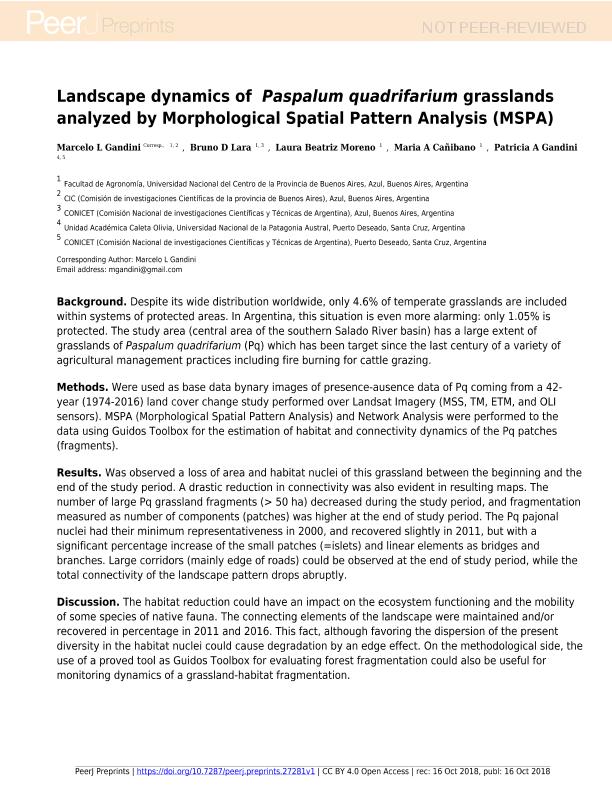Artículo
Landscape dynamics of Paspalum quadrifarium grasslands analyzed by Morphological Spatial Pattern Analysis (MSPA)
Gandini, Marcelo Luciano; Lara, Bruno Daniel ; Moreno, Laura Beatriz; Cañibano, María Alejandra; Gandini, Patricia Alejandra
; Moreno, Laura Beatriz; Cañibano, María Alejandra; Gandini, Patricia Alejandra
 ; Moreno, Laura Beatriz; Cañibano, María Alejandra; Gandini, Patricia Alejandra
; Moreno, Laura Beatriz; Cañibano, María Alejandra; Gandini, Patricia Alejandra
Fecha de publicación:
10/2018
Editorial:
PeerJ Inc
Revista:
PeerJ
ISSN:
2376-5992
e-ISSN:
2167-8359
Idioma:
Inglés
Tipo de recurso:
Artículo publicado
Clasificación temática:
Resumen
Background. Despite its wide distribution worldwide, only 4.6% of temperate grasslands are includedwithin systems of protected areas. In Argentina, this situation is even more alarming: only 1.05% isprotected. The study area (central area of the southern Salado River basin) has a large extent ofgrasslands of Paspalum quadrifarium (Pq) which has been target since the last century of a variety ofagricultural management practices including fire burning for cattle grazing.Methods. Were used as base data bynary images of presence-ausence data of Pq coming from a 42-year (1974-2016) land cover change study performed over Landsat Imagery (MSS, TM, ETM, and OLIsensors). MSPA (Morphological Spatial Pattern Analysis) and Network Analysis were performed to thedata using Guidos Toolbox for the estimation of habitat and connectivity dynamics of the Pq patches(fragments).Results. Was observed a loss of area and habitat nuclei of this grassland between the beginning and theend of the study period. A drastic reduction in connectivity was also evident in resulting maps. Thenumber of large Pq grassland fragments (> 50 ha) decreased during the study period, and fragmentationmeasured as number of components (patches) was higher at the end of study period. The Pq pajonalnuclei had their minimum representativeness in 2000, and recovered slightly in 2011, but with asignificant percentage increase of the small patches (=islets) and linear elements as bridges andbranches. Large corridors (mainly edge of roads) could be observed at the end of study period, while thetotal connectivity of the landscape pattern drops abruptly.Discussion. The habitat reduction could have an impact on the ecosystem functioning and the mobilityof some species of native fauna. The connecting elements of the landscape were maintained and/orrecovered in percentage in 2011 and 2016. This fact, although favoring the dispersion of the presentdiversity in the habitat nuclei could cause degradation by an edge effect. On the methodological side, theuse of a proved tool as Guidos Toolbox for evaluating forest fragmentation could also be useful formonitoring dynamics of a grassland-habitat fragmentation.
Palabras clave:
LAND USE
,
CATTLE GRAZING
,
MORPHOLOGY
,
CONNECTIVITY
,
PASPALUM QUADRIFARIUM
Archivos asociados
Licencia
Identificadores
Colecciones
Articulos(CCT - TANDIL)
Articulos de CTRO CIENTIFICO TECNOLOGICO CONICET - TANDIL
Articulos de CTRO CIENTIFICO TECNOLOGICO CONICET - TANDIL
Citación
Gandini, Marcelo Luciano; Lara, Bruno Daniel; Moreno, Laura Beatriz; Cañibano, María Alejandra; Gandini, Patricia Alejandra; Landscape dynamics of Paspalum quadrifarium grasslands analyzed by Morphological Spatial Pattern Analysis (MSPA); PeerJ Inc; PeerJ; 6; 10-2018; 1-24
Compartir



